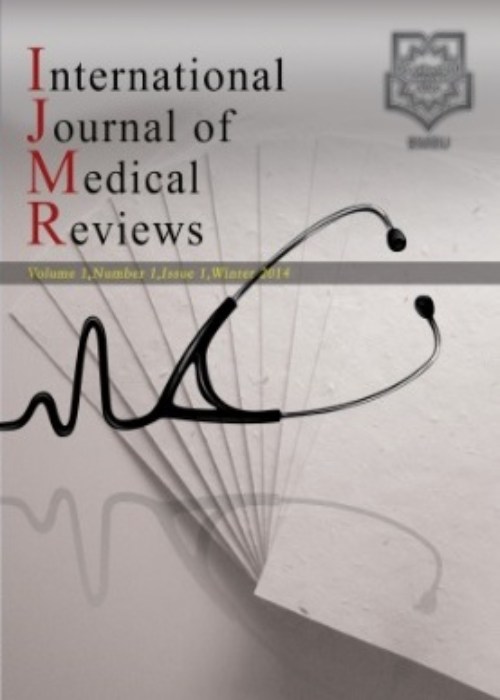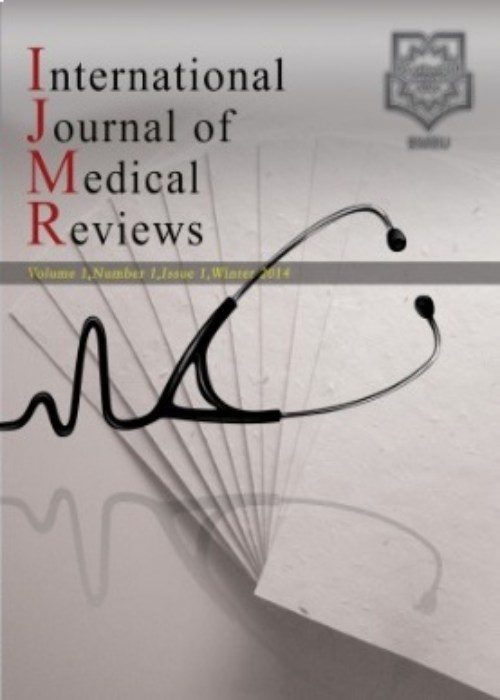فهرست مطالب

International Journal of Medical Reviews
Volume:10 Issue: 1, Winter 2023
- تاریخ انتشار: 1402/03/10
- تعداد عناوین: 6
-
-
Pages 419-439BackgroundPre-emptive analgesia using pudendal nerve block (PNB) with bupivacaine is commonly used in clinical practice during perineal, pelvic floor or vaginal surgeries. However, its effectiveness is unclear. We conducted this review to synthesize short- and intermediate-term outcomes of pre-emptive analgesia using pudendal nerve block with bupivacaine.MethodsWe searched the CENTRAL, PubMed, ClinicalTrials.gov, Google Scholar, and Open Grey from inception until April 2020. Randomized controlled trials (RCTs) of women who underwent perineal, pelvic floor or vaginal surgeries and received pre-emptive analgesia using a pudendal nerve block were included. Two authors independently screened, selected and performed data extraction as well as quality assessment on eligible trials. Disagreements were resolved via consensus. Data were narratively synthesized; when possible, data were pooled in RevMan 5 using the random-effects model.ResultsFour RCTs with a total of 349 participants were eligible for inclusion. We found evidence of improvement in postoperative pain scores; requirements for opioids, standardized mean difference (SMD): -0.89 (95% CI: -1.19, -0.59) and nonsteroidal anti-inflammatories SMD -1.04 (95% CI: -1.64, -0.43) in favor of the PNB versus control group. The risk ratio for adverse effects of postoperative nausea and vomiting, 0.42 (95% CI: 0.18, 0.99) favored PNB. There was no significantdifference between groups for the length of hospital stay, mean difference -0.82 (95% CI: -5.34, 3.69) and return to regular activity.ConclusionWe found limited evidence that pre-emptive pudendal block using bupivacaine improves postoperative pain and recovery in perineal, pelvic floor or vaginal surgeries. However, due to the heterogeneous nature of evidence, well-designed RCTs are required.Keywords: Pre-emptive Analgesia, Bupivacaine, Pudendal Nerve Block, Vaginal Surgery, Pelvic organ prolapse, Meta-analysis
-
Pages 435-446
Consanguineous marriages have been practiced for thousands of years in many communities throughout the world. Birth defects contribute significantly to infant mortality rate (IMR), and they may be associated with consanguinity. Therefore, the objective of this review is to compile an overview of the findings on consanguinity and genetic diseases in the population of Brazil. We collect data from PubMed (January 2000 to July 2020), and data from the Modell Global Database of Congenital Disorders (MGDb) estimates for 2010-2014 in the Americas. The PubMed database yielded 199 results that met the inclusion/ exclusion criteria search. We observe a higher risk ratio (RR: 4.16, 95% CI 4.07-4.25) for consanguineous marriages compared with two other Brazilian studies. The highest coefficient of consanguinity was found in the city of Lagoa (F = 0.01182), state of Paraíba. In the same period (2010-2014), the coefficient of consanguinity was 0.0027, while the IMR was 20.3/1,000 live births in Brazil. The Kruskal-Wallis test used to compare Brazil and others country’s estimates was also statistically significant (H = 73.55, p<0.0001). Fifteen genetic diseases associated with consanguinity have been observed. Among these, a new mutation in pycnodysostosis disease (#265800, CTSK gene, c.953G>A), and Raine syndrome (#259775, FAM20C, c.1487C>T; p.P496L) are the diseases that stand out. With these results, we believe that the public health system should be working directly with the local communities in actions that include the creation of banks of genes/mutations related to consanguineous couples, neonatal screening and health education.
Keywords: Coefficient of consanguinity, consanguineous marriages, Genetic Diseases, Infant Mortality, Brazil -
Pages 447-455
COVID-19 is a major emerging disease that will affect any specific disease. However, a recent report suggests the occurrence of hyperglycemia without any present diabetes in COVID-19 patients. This study aimed to systematically review recent evidence on hyperglycemia in COVID-19 patients. Literature research was done using four search engines, consist of Google Scholar, PubMed, ScienceDirect, and ProQuest, and limited to English manuscripts only and published in the last 1 year. SARS-CoV-2 could damage the pancreas by causing the destruction of the β-cell structure that leads to impairment of glucose metabolism and worsen pre-existing diabetes or determine the appearance of hyperglycemia in non-diabetes. Inflammation also plays a major important role in hyperglycemia related to COVID-19. Hyperglycemia increased the vulnerability of the lung, by promoting and facilitating the entry of the SARS-CoV-2 into the host cells, and decreasing lung function. Moreover, the mortality and morbidity rate conceivable increased due to hyperglycemia. The presence of high glucose levels is linked with the progression of COVID-19 severity. Thus, the glucose level should be concerned, either in a patient with present diabetes or without any presence of diabetes. Examination and monitoring of glucose levels might be a useful tool to prevent the seriousness of COVID-19.
Keywords: Diabetes Mellitus, SARS-CoV-2, High Glucose Level, Pulmonary Infection -
Pages 456-462Introduction
Coronary angiography is a common test for diagnosis of coronary artery disease. Coronary angiography, despite its benefits in diagnosing the disease, due to its invasive nature, it can cause psychological complications such as anxiety. The objective of this rapid systematic review is to assess the efficacy of educational interventions for reducing anxiety of patients undergoing coronary angiography.
MethodsIn this rapid systematic review, all published, peer-reviewed, English-language interventional studies from 2010 to 2020 were identified in a search of Scopus, PubMed, and Google Scholar databases. Relevant studies were assessed with experimental and quasi-experimental designs that evaluated the interventions for anxiety control in patients undergoing coronary angiography. Data were extracted from studies and assessed.
ResultsTotally, 36 studies with 3966patients that evaluated the interventions for anxiety control in these patients wereincluded. The types of interventions made to control anxiety in patients undergoing angiography include the use of educational videos, written education, peer-based education, verbal education, conducting educational tours, familiarization with the department and procedure.
ConclusionThe findings of these studies suggest that teaching the patient before coronary angiography is one of the nonpharmacological, safe and low-cost methods with effectiveness in reducing anxiety. According to the results of this study, different educational methods can be used to reduce and relieve anxiety before performing coronary angiography compared to routine methods.
Keywords: Systematic review, anxiety, Coronary Angiography, Educational Interventions -
Pages 463-476
Cardiovascular diseases (CVD) and cognitive decline both impart a significant burden on the life and livelihood of elderlypeople. Growing evidence suggests an association between CVD burden with changes in cognitive outcomes. This narrative review aimed to compile, synthesize, compare, and critique findings from articles of the last 10 years regarding the temporal relationship between CVD burden and cognitive function among older adults. Electronic databases of PubMed and Google Scholar were searched for prospective cohort studies that estimated CVD burden in the form of the presence of CVDs, or assessment of health through CVD risk models and determined temporal change in cognitive function by either detailing cognitive decline or incident dementia/cognitive impairment. Seventeen original articles met with eligibility criteria during the screening process and were included. The follow-up period of the prospective cohort studies ranged from 24 months- 41 years. Framingham General CVD Risk Score and Atrial Fibrillation were the most frequently found CVD risk model and cardiovascular diseases associated with cognitive change, respectively. Incidence of dementia/cognitive impairment in various studies ranged from 4.2-14.9%. All but one of the studies had shown a positive longitudinal association between CVD burden and cognitive decline among the study participants. Consistent findings of the temporal relationship between CVD risk models and cognitive decline in the review pave the way for operationalizing preventive strategies that act on multiple cardiovascular risk factors before old age. Strategic reform and capacity building in pre-existing CVD health infrastructures could effectively reduce the dementia burden of any specific country
Keywords: Cardiovascular Diseases, Cognitive dysfunction, dementia, Elderly -
Pages 477-484IntroductionThe aim of this study was to investigate the role of mental health and personality traits in predicting job burnout among sellers of CANBO store in Tehran.MethodsThe research method was descriptive-correlational and the statistical population of the present study included all sellers of CANBO store in Tehran in 2021-2022 that 265 people were selected as the sample size by stratified random sampling method using Krejcie and Morgan table. The instruments used included the Maslach Burnout Questionnaire (MBI) and the NEO Five Personality Factors Questionnaire (NEO-FFI). Pearson correlation and regression analysis were used to analyze the data using SPSS software version 22.ResultsThe results showed that there is a negative relationship between mental health and burnout (p = 0.001); Also, there was a positive and significant relationship between burnout and annoyance, conscientiousness and openness to experience as components of personality traits, and a negative and significant relationship between burnout and extraversion and adaptation of personality components (p = 0.001). The results of regression analysis also showed that both predictors of mental health and personality traits components were able to predict burnout in sellers and explained (32.7%) of the changes in burnout.ConclusionGiven the relationship between burnout and mental health and personality traits of sellers of CANBO stores, it is necessary for the heads and managers of these stores to develop programs to improve motivation, job satisfaction, human relations and identify personality traits of sellers in order to Design and implement job productivity enhancement.Keywords: burnout, mental health, personality traits, Sellers


